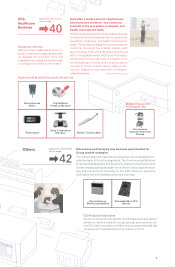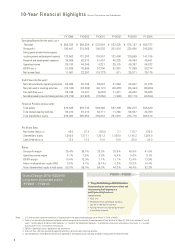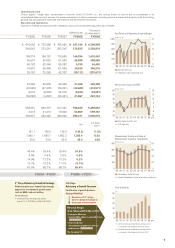Omron 2009 Annual Report Download - page 18
Download and view the complete annual report
Please find page 18 of the 2009 Omron annual report below. You can navigate through the pages in the report by either clicking on the pages listed below, or by using the keyword search tool below to find specific information within the annual report.
16
President Sakuta Discusses Omron’s Future
The three main control-based businesses remain susceptible to economic fluc-
tuations. What steps have been taken to address this issue?
Q
Building a Production Structure Resilient to
Fluctuations in Demand
The industrial sector is the main market for IAB, ECB,
and AEC and, for that reason, their results are inevitably
prone to fluctuate with the economy. We can, how-
ever, take steps to make them more adaptable to
changes in the business climate by dispersing opera-
tions geographically and diversifying business content.
Nevertheless, the global recession has made this sus-
ceptibility glaringly apparent. While acknowledging
that an impact is inevitable during periods of growing
economic uncertainty, we must urgently increase their
resilience to fluctuations in demand.
One step, which we will take while concurrently
ramping up production capacity for EMC, will be to
create an optimized, hierarchical manufacturing sys-
tem. We are gathering our specialized technologies in
materials, processing, metal molds, and other areas
into our integrated “mother” plant in Japan. These
technologies form the nucleus from which arises the
unmatched strength of Omron’s products. From this
centralized factory, we will then supply products,
assembly equipment, and inspection equipment to
mass-production plants and subcontractors around
the world. We will also retool our second-tier mass-
production factories around the world for mass
production of general-purpose products and continue
supporting our subcontractors in other regions by com-
missioning small-scale production of general-purpose
products. This three-tier hierarchy of manufacturing
operations will further raise QCD while remaining
resilient to fluctuations in demand.
Optimal Hierarchy (Factory)
Integrated factory
(Domestic “mother” factory)
Established elemental technology
Supplying key parts and equipment for
assembly and inspection
Mass-production factories
(Worldwide)
Large-scale production of general-
purpose products
Supporting subcontractors
Subcontractors
(Worldwide)
Low volume production of general-
purpose products
Efficient And Strengthened Production Capabilities by Three-tiered
Hierarchy System
Consolidating strengths of the three main control-based businesses
FA Business EMC ME
Auto-
motive
relay,
switches
ECU
etc.
IAB
Mechanical Components Business
New growth fields (MEMS, etc)
Spin off
ECB AEC
)
FA Business
ME
Spin off
ECU
etc.
IAB
Others
AEC
Strengths:
Distribution channeles
for general-purpose products
Strengths:
Global production capabilities
and technologies
FA: Factory Automation EMC: Electronic and Mechanical Components (Electronic mechanical components, such as relays, switches, connectors, etc.) ME: Micro Electronic components
(Electronic components, MEMS, and other electronic components such as liquid-crystal backlights, etc.) ECU: Electronic Control Units (Automotive electronic control units)
Production
of automotive
relays and
switches
Production
of industrial
relays and
switches
EMC
a roughly 50% increase in staff, and creating stronger
alliances with domestic distributors. We also plan to
integrate the sales and marketing functions of ECB’s
distribution channels into IAB.
Omron’s share of the domestic market for control
equipment remains solid at roughly 40%, according
to Nippon Electric Control Equipment Industries
Association standards, but it has slipped by five per-
centage points over the past 10 years. Our
performance objective is to regain market share of
45% over the short term.
We have decided to have ECB focus its expertise
on mechanical components and rename the segment
the Electronic and Mechanical Components (EMC)
Business Company, with the new name taking effect
in September 2009. EMC will take over the develop-
ment and manufacturing of mechanical components
currently conducted in each of the IAB, ECB, and AEC
segments to provide integrated development and
manufacture of industrial, consumer electronics,
telecommunication, and automotive relays, switches,
and connectors.
With ECB focusing on mechanical components,
micro electronic (ME) components operations will be
shifted from ECB to the Others segment. Micro elec-
tronic components encompass liquid-crystal backlights
and micro electro mechanical systems (MEMS), to
which Omron has dedicated significant effort to date.
ME is rapidly developing into a new growth field and
will be under my direct supervision as we aggressively
develop and expand our ME operations.
























